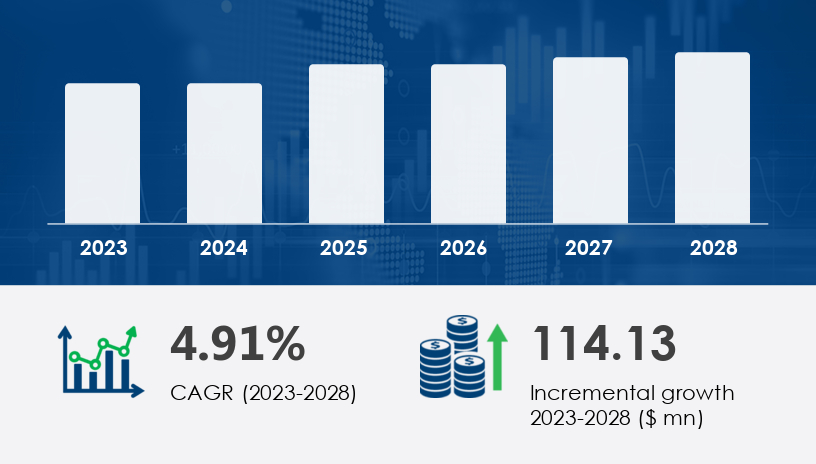The global bismuth market is projected to grow by USD 114.13 million from 2024 to 2028, expanding at a CAGR of 4.91%. The market is experiencing steady growth due to rising bismuth demand for thermoelectric materials, which play a crucial role in improving energy efficiency and reducing carbon emissions. Increasing use in automotive, power generation, pharmaceuticals, cosmetics, and electronics sectors is driving market expansion. Innovations in bismuth technology and metallurgical processes have also contributed to the growth of bismuth applications, particularly in the development of high-performance alloys.However, limited availability of bismuth reserves poses a challenge to bismuth suppliers and market growth. To ensure steady bismuth production, companies are exploring alternative sources and recycling methods. Despite this challenge, increasing industrial applications and bismuth innovations are expected to support the expansion of the global bismuth market over the forecast period. With rising bismuth adoption in various industries and competitive market dynamics, new bismuth opportunities continue to emerge. Additionally, fluctuations in bismuth pricing and growing bismuth competition among suppliers highlight the evolving landscape of this expanding industry.

For more details about the industry, get the PDF sample report for free
Middle East and Africa
South America
APAC is expected to contribute 46% to the global market growth during the forecast period. Countries such as China, Japan, and South Korea are key consumers due to their rapid industrialization, urbanization, and high demand for electronics and automotive products. China, Taiwan, and Japan lead in electronics manufacturing, where bismuth is widely used in lead-free soldering. Additionally, the automotive sector in APAC is witnessing substantial growth, further driving demand for bismuth-based catalytic converters and alloys.
In North America, particularly the United States, demand for bismuth-based personal care and cosmetic products is on the rise. Bismuth compounds such as bismuth oxychloride are widely used in foundations, powders, and skin-care products due to their antibacterial properties and shimmering effects. The increasing awareness of health and wellness trends is further fueling demand for bismuth-based cosmetics in the region.
Meanwhile, Germany remains a key player in Europe’s industrial sector, utilizing bismuth in automotive alloys, metallurgy, and pharmaceuticals. The Middle East, Africa, and South America also contribute to the market, but at a slower growth rate due to economic and industrial limitations.
The bismuth extraction process involves complex ore processing techniques, including hydrometallurgical and pyrometallurgical methods. Leaching agents, solvent extraction, and precipitation techniques are widely used to obtain high-purity bismuth concentrates. Smelting and refining techniques play a crucial role in ensuring bismuth’s usability in pharmaceuticals, electronics, and cosmetics. The growing adoption of bismuth oxide, bismuth subsalicylate, and bismuth oxychloride in pharmaceutical applications, pigments, and electronics is fueling the market. Crushing, grinding, and beneficiation techniques are being optimized to improve extraction efficiency and cost-effectiveness. Bismuth ingots, powders, and pellets are increasingly used in optical lenses, optoelectronics, and antibacterial coatings.
Get more details by ordering the complete report
These companies are actively engaged in strategic alliances, mergers, acquisitions, and product innovations to strengthen their market position.
Bismuth’s antibacterial properties, chemical stability, and shimmering effects make it a preferred material in cosmetics and medical applications. The increasing focus on environmentally sustainable solutions has led to innovations in bismuth-based alloys for automotive and battery applications.The mining industry is enhancing social media engagement and digital marketing strategies to increase awareness about bismuth-based solutions. Customer engagement, promotional offers, and transactional notifications are being used to drive demand in sectors such as cosmetics, pharmaceuticals, and electronics. Bismuth’s application in Helicobacter pylori treatment, mineral-based makeup, and industrial alloys is expected to expand, ensuring sustained market growth.
Safe and Secure SSL Encrypted